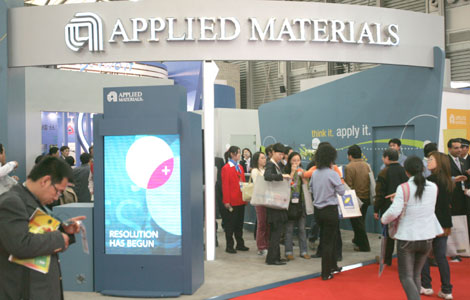
 |
|
The Applied Materials' stand at the Munich Shanghai Electronic Exhibition. The company's revenue in China increased sharply last year, to which the solar segment made a big contribution. [Photo / China Daily] |
"We need to work together to drive down costs even though it is a difficult time and we both lose money," Pinto said. "We are making more investment, trying to help the industry to develop in a healthy way."
Gay shared that view.
A graduate of the University of California who majored in physical chemistry, Gay said solar energy was his chosen interest since he was eight years old.
"As the son of a long line of farmers, I have always been interested in solar and Mother Nature and became especially interested in photovoltaics at the time of the first oil embargo in 1973," he said.
He served in roles ranging from director of research to president of the company. In 1990, he became president and chief operating officer of Siemens Solar Industries, where he was responsible for expanding the development of thin film solar technology.
In 1998, he was president and chief executive officer of ASE Americas, the third-largest solar cell manufacturer in the US. He joined Applied Materials in 2006, the year the company started construction of its new office and research center in Xi'an, Shaanxi province.
Three years later, the Xi'an Solar Technology Center of the company was completed and put into operation. It serves as a center for basic research, process development, technology scale validation, customer training and ongoing support services.
The company invested $300 million in the center, which is the largest privately funded solar technology research facility in the world. In 2011, company figures show it spent 1.1 billion yuan ($174 million) on research and development.
"We need to help our customers innovate and drive down costs," Gay said.
Applied Materials' performance last year was not bad. The company not only sells equipment but also offers technology services to clients.
Revenue in China increased sharply from $1.5 billion in 2010 to $2.5 billion in 2011, to which the solar segment made a big contribution, according to the company.
Sales in the Chinese mainland took up 24 percent and those in Taiwan accounted for 20 percent of global sales, the company said.
"China is the fastest-growing market and our future focus," Gay said. "We will invest more in the country and try to continue reducing the cost of PV solar cells."
Gay said research on second-generation technology for PV solar cell production has been conducted for years by the company.
He told China Daily that Canadian Solar Ltd is already producing second-generation cells using equipment from Applied Materials.
However, Gay said that gaining grid access for renewable energy is the biggest challenge to China's new energy development.
He said that the Chinese government is more visionary than other countries.
"We need to help the solar industry grow by opening up and creating free trade," he said. "But for China, it is a delicate balance."
Future vision
By 2050, many coal-fired power plants will be retired and there will be 9 billion people who will need three times as much electricity as what we are using today, said Gay.
He said by then, one-third of power will come from PV solar facilities.
In California, solar power will be the first choice for electricity by 2030, which sends a message to China, he said.
China uses a unified time system, even though its large area spans three time zones. During peak electricity demand in the early evening in the east, the western part of China can still provide solar energy in the daytime, so solar can be the best solution for China, Gay explained.
Moreover, China's western area has abundant solar resources.
A report by McKinsey & Co said the prices of PV solar products are falling and governments are reducing subsidies, but the manufacturing capacity of the industry will still double worldwide in three to five years.
By the end of 2020, the cost of solar products will fall by 10 percent and companies will benefit by controlling costs and developing innovative products.
The report said India and most regions in Africa, where the grid has gaps, offer huge potential for solar PV applications.
Gay was headed to Japan after the trip in Xi'an because the company has a growing number of clients there.
"The PV solar markets in Japan and India are growing rapidly. South Africa, Brazil and Thailand are all potential markets for the PV industry," he said.
Back in the US, Gay's home, and that of his brother, are PV-powered. Gay said that situation couldn't have happened during his childhood or in the lifetimes of his father and grandfather. The prices of traditional energy will increase and the prices of renewable energy will fall, he said.
"Being able to apply my education to a meaningful problem and make a difference for future generations has proven to be a truly unique opportunity for my career," he said.
dujuan@chinadaily.com.cn